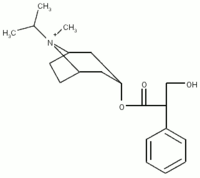Goggin N, Macarthur C, Parkin PC. Randomized trial of the addition of ipratropium bromide to albuterol and corticosteroid therapy in children hospitalized because of an acute asthma exacerbation. Arch Pediatr Adolesc Med 2001; 155:1329-34.
* BACKGROUND Adding 2 to 3 doses of ipratropium bromide (Atrovent) to conventional therapy with inhaled [beta]-agonists and systemic corticosteroids improves lung function and decreases hospital admissions when given in the emergency department (ED). This study evaluated whether ipratropium bromide administration improves outcomes in children who require subsequent hospitalization.
* POPULATION STUDIED The authors enrolled 80 children aged 1 to 18 years with a history of asthma admitted to the pediatric inpatient unit of a tertiary-care urban hospital. Children had to have moderate to severe symptoms upon admission, defined as requiring inhaled [[beta].sub.2]-agonists at least every 2 hours, having a forced expiratory volume in 1 second ([FEV.sub.1]) of 25% to 80% of predicted, or having a clinical asthma score of 3 to 9 out of a possible 10. The clinical asthma score is a total of 5 items--respiratory rate, wheezing, inspiratory-expiratory ratio, retracting, and observed dyspnea--scored on a 3-point scale. Excluded patients had coexisting cardiac, neurologic, immunosuppressive, or other chronic pulmonary disease, hypersensitivity to the study drugs, or known ocular abnormalities. Children were excluded if their asthma score was 10, if they needed airway intervention, or if more than 12 hours had elapsed between the first nebulizer treatment and admission.
* STUDY DESIGN AND VALIDITY This was a double-blind randomized controlled trial. Study patients received frequent nebulized albuterol at 0.15 mg/kg as well as either IV hydrocortisone at 4 to 6 mg/kg every 6 hours or oral prednisone 1 mg/kg once daily. Attending physicians determined nebulizer treatment frequency, ranging from 30 minutes to 4 hours. Subjects were randomized to receive either ipratropium bromide or normal saline, matched to the albuterol dosing interval. Participants were stratified by age (less than 5 years vs 5 years or more) and by the number of ipratropium bromide doses they received in the ED (3 or less vs more than 3). Investigators used an intention-to-treat analysis and allocation was concealed.
This study was well designed and well executed. The authors reported that the study had a 90% power to detect a difference in clinical asthma score as small as 0.9. The authors defined a "clinically meaningful difference" as a change in the clinical asthma score of 1.5.
* OUTCOMES MEASURED The primary outcome was the clinical asthma score, measured at baseline and every 6 hours until discharge. The clinical score is reproducible, valid, and predictive. Secondary outcomes included oxygen saturation, [FEV.sub.1], length of stay, time to a 4-hour albuterol dosing interval, and readmission to the hospital or ED within 72 hours of discharge.
* RESULTS Of the 212 patients assessed for the trial, only 99 were eligible. Of these, 84 parents consented to enroll their children (4 children were later determined not to meet inclusion criteria and were excluded). The ipratropium and placebo groups were essentially the same. There was no difference in the asthma score between treatment and control groups in 3 of the 4 subgroups. In one subgroup--those who had fewer than 3 doses of ipratropium bromide in the ED--ipratropium provided a slight benefit. The difference in change in scores was 0.5 on the clinical asthma score, a statistically but not clinically important change. There were no differences in the secondary outcomes. The average heart rate was 6 to 10 beats per minute greater in the ipratropium group. The authors noted no transient anisocoria, a potential adverse effect of ipratropium bromide in children.
RECOMMENDATIONS FOR CLINICAL PRACTICE
Giving ipratropium bromide to children with moderate to severe asthma exacerbations reduces admissions and asthma symptoms when given with appropriate [beta]-agonists and corticosteroids in the ED. Ipratropium bromide provides no further benefit for children who require hospitalization after receiving the drug in the ED; therefore, adding ipratropium bromide to standard in-hospital care is not beneficial.
Kelly Hayday, MD James J. Stevermer, MD, MSPH Department of Family and Community Medicine University of Missouri-Columbia E-mail: haydayk@health.missouri.edu
COPYRIGHT 2002 Appleton & Lange
COPYRIGHT 2002 Gale Group



